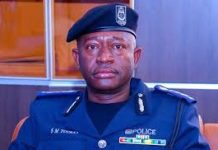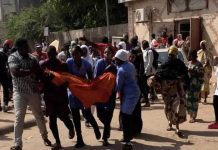By Amie Sanneh The governor of Central Bank of the Gambia has said that in the year to end-June 2014, the country’s domestic debt rose to D14.7 billion, or 29.3 percent from a year earlier. He added that Treasury bills and Sukuk-AI Salaam bill, accounting for 82.4 percent and 4.0 percent of the domestic debt stock increased by 36.1 percent and 50.1 percent respectively. The Central Bank Governor made the disclosure yesterday 7 July 2014 during the Monetary Policy Committee Press Briefing held at the Board Room of the Bank. He further stated that provisional data on Government fiscal operations for the first half of 2014 indicate that total revenue and grants increased to D4.12 billion (22 percent of GDP), or 26.0 percent from the corresponding period in 2013. “The out turn was also higher than the target of D4.10 billion (21.0 percent of GDP). Domestic revenue, comprising tax and non-tax revenue, amounted to D3.16 billion, higher than the D2.82 billion in the first half of 2013 and the target of D3.14 billion attributed mainly to the 14.0 percent increase in tax revenue. Non-tax revenue, on the other hand, rose by only 2.0 percent,” he said. Governor Colley added that expenditure and net lending totaled D4.9 billion (26 percent of GDP), higher than the outturn of D4.2 billion (25 percent of GDP) and the projection of D4.83 billion. Current and capital expenditure rose to D3.3 billion and D1.5 billion compared to D3.0 billion and D1.2 billion respectively in the corresponding period in 2013, he said. The overall budget balance (including grants) recorded a deficit of D778.5 million (4.0 percent of GDP) which was financed by both domestic and foreign sources, he explained. Governor Colley explains that the growth outlook for the Gambian economy has moderated since the previous meeting of the MPC. “Owing to uncertainties surrounding agricultural production due to the prospects of inadequate rainfall, real GDP is projected at 5.3 percent in 2014, slightly lower than the 5.6 percent in 2013 and the earlier forecast of between 6.0-6.5 percent. Agriculture value-added is forecast to increase by 12.5 percent, industry (2.9 percent) and services (3.6 percent),” he stated. On Money and Banking Sector Developments, the CBG Governor recalled that in the year to end-June 2014, money supply grew by 8.1 percent, lower than the 14.8 percent a year ago and the target of 15.0 percent. “The deceleration in the growth of money supply was mainly the result of slower pace of expansion of the net domestic assets (NDA) and the contraction in the net foreign assets (NFA) of the banking system. The NDA rose to D13.6 billion, or 12.6 percent, but lower than the growth rate of 15 percent a year earlier. The NFA contracted to D4.95 billion, or 2.5 percent,” he said. Commenting on reserve money, he said the Bank’s operating target increased to D5.78 billion, or 19.7 percent. Although reserve money growth was above the target of 13.5 percent, it was lower than the strong expansion of 26.4 percent a year earlier, he said. According to him, the decrease in the pace of expansion of reserve money was mainly the result of the contraction in the NFA of the Central Bank by 8.4 percent compared to the robust growth of 21.4 percent a year ago. The NDA of the Central Bank, on the other hand, Governor Colley stated, increased significantly to D2.5 billion, or 97.2 percent. Central Bank net claims on government rose from D1.3 billion in June 2013 to 02.2 billion in June 2014, he said. The banking sector, he continued, remains fundamentally sound. Recent data indicate that capital and reserves increased to D3.45 billion in June 2014, or 16.2 percent from June 2013, he said. The risk weighted capital adequacy ratio averaged 35.1 percent, higher than the minimum requirement of 10.0 percent he said. He further stated that all the banks met the capital adequacy requirement. Total assets, the Governor explains, increased to D25.57 billion or 14.2 percent from a year earlier, Gross loans and advances which accounted for 23.4 percent of total assets decreased to D5.97 billion, or 2.3 percent from June 2013.Private sector credit, net of provisions declined from D4.42 billion in June 2013 to D4.09 billion in June 2014. The CBG Governor pointed out that the non-performing loans (NPL) ratio increased from 11.3 percent in June 2013 to 16.0 percent in June 2014. Deposit liabilities totaled D15.15 billion in June 2014, higher than the D14.28 billion in June 2013. The banking industry, he said, has recorded a net income of D197.0 million in the first six months of 2014 compared to D80.6 million in the corresponding period in 2013. He explained that the return on assets was 3.3 percent and return on equity 21.3 percent compared to 1.7 percent and 10.8 percent respectively in the first half of 2013. Governor Colley said since the previous meeting of the Monetary Policy Committee (MPC), the International Monetary Fund (IMF) has revised global growth projections for 2014 from 3.7 percent to 3.0 percent. He stated that growth in advanced economies is forecast at 1.8 percent in 2014, higher than the 1.3 percent in 2013. The GDP growth for Sub-Saharan Africa, Governor Colley said, is projected at 5.4 percent from 4.8 percent in 2013, premised on improved agricultural production, increased private consumption and expansion in commodity related projects. According to the CBG Governor, Global crude oil prices have fluctuated in recent months reflecting mainly geopolitical developments. “Year-to-date, oil prices averaged US$105.3 per barrel, slightly higher than the average of US$105.09 per barrel a year earlier,” he said. Global inflation remains benign in advanced economies, although the risk of deflation in the Euro zone persists reflecting the combination of the substantial output gap, the decline in the prices of commodities especially fuels and food and low inflation expectations. In emerging markets and developing economies, inflation is expected to decline from about 6 percent in 2014 to about 5 percent in 2015. To the extent that the decline in global commodity prices should help reduce price pressures, this reduction is more than offset by recent exchange rate depreciations in a number of emerging and developing countries, including The Gambia.
Domestic Debt Rises to D14.7 Billion Overall budget balance record a deficit of D778.5 million
Facebook Notice for EU!
You need to login to view and post FB Comments!




















